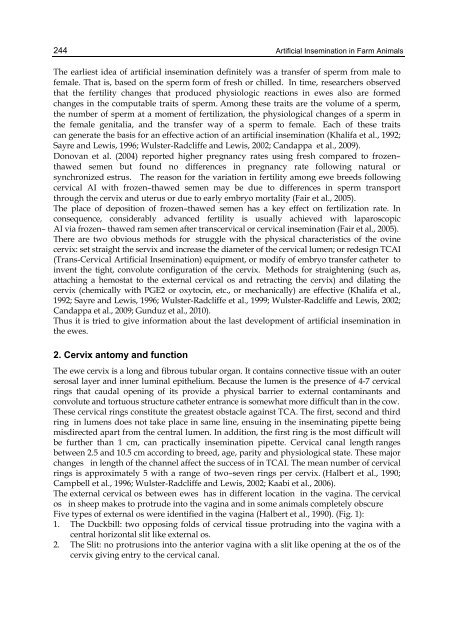ARTIFICIAL INSEMINATION IN FARM ANIMALS - Phenix-Vet
ARTIFICIAL INSEMINATION IN FARM ANIMALS - Phenix-Vet
ARTIFICIAL INSEMINATION IN FARM ANIMALS - Phenix-Vet
You also want an ePaper? Increase the reach of your titles
YUMPU automatically turns print PDFs into web optimized ePapers that Google loves.
244Artificial Insemination in Farm AnimalsThe earliest idea of artificial insemination definitely was a transfer of sperm from male tofemale. That is, based on the sperm form of fresh or chilled. In time, researchers observedthat the fertility changes that produced physiologic reactions in ewes also are formedchanges in the computable traits of sperm. Among these traits are the volume of a sperm,the number of sperm at a moment of fertilization, the physiological changes of a sperm inthe female genitalia, and the transfer way of a sperm to female. Each of these traitscan generate the basis for an effective action of an artificial insemination (Khalifa et al., 1992;Sayre and Lewis, 1996; Wulster-Radcliffe and Lewis, 2002; Candappa et al., 2009).Donovan et al. (2004) reported higher pregnancy rates using fresh compared to frozen–thawed semen but found no differences in pregnancy rate following natural orsynchronized estrus. The reason for the variation in fertility among ewe breeds followingcervical AI with frozen–thawed semen may be due to differences in sperm transportthrough the cervix and uterus or due to early embryo mortality (Fair et al., 2005).The place of deposition of frozen–thawed semen has a key effect on fertilization rate. Inconsequence, considerably advanced fertility is usually achieved with laparoscopicAI via frozen– thawed ram semen after transcervical or cervical insemination (Fair et al., 2005).There are two obvious methods for struggle with the physical characteristics of the ovinecervix: set straight the servix and increase the diameter of the cervical lumen; or redesign TCAI(Trans-Cervical Artificial Insemination) equipment, or modify of embryo transfer catheter toinvent the tight, convolute configuration of the cervix. Methods for straightening (such as,attaching a hemostat to the external cervical os and retracting the cervix) and dilating thecervix (chemically with PGE2 or oxytocin, etc., or mechanically) are effective (Khalifa et al.,1992; Sayre and Lewis, 1996; Wulster-Radcliffe et al., 1999; Wulster-Radcliffe and Lewis, 2002;Candappa et al., 2009; Gunduz et al., 2010).Thus it is tried to give information about the last development of artificial insemination inthe ewes.2. Cervix antomy and functionThe ewe cervix is a long and fibrous tubular organ. It contains connective tissue with an outerserosal layer and inner luminal epithelium. Because the lumen is the presence of 4-7 cervicalrings that caudal opening of its provide a physical barrier to external contaminants andconvolute and tortuous structure catheter entrance is somewhat more difficult than in the cow.These cervical rings constitute the greatest obstacle against TCA. The first, second and thirdring in lumens does not take place in same line, ensuing in the inseminating pipette beingmisdirected apart from the central lumen. In addition, the first ring is the most difficult willbe further than 1 cm, can practically insemination pipette. Cervical canal length rangesbetween 2.5 and 10.5 cm according to breed, age, parity and physiological state. These majorchanges in length of the channel affect the success of in TCAI. The mean number of cervicalrings is approximately 5 with a range of two–seven rings per cervix. (Halbert et al., 1990;Campbell et al., 1996; Wulster-Radcliffe and Lewis, 2002; Kaabi et al., 2006).The external cervical os between ewes has in different location in the vagina. The cervicalos in sheep makes to protrude into the vagina and in some animals completely obscureFive types of external os were identified in the vagina (Halbert et al., 1990). (Fig. 1):1. The Duckbill: two opposing folds of cervical tissue protruding into the vagina with acentral horizontal slit like external os.2. The Slit: no protrusions into the anterior vagina with a slit like opening at the os of thecervix giving entry to the cervical canal.










